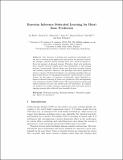Files in this item
Bayesian inference federated learning for heart rate prediction
Item metadata
| dc.contributor.author | Fang, L. | |
| dc.contributor.author | Liu, X. | |
| dc.contributor.author | Su, X. | |
| dc.contributor.author | Ye, J. | |
| dc.contributor.author | Dobson, S. | |
| dc.contributor.author | Hui, P. | |
| dc.contributor.author | Tarkoma, S. | |
| dc.contributor.editor | Ye, Juan | |
| dc.contributor.editor | O'Grady, Michael J. | |
| dc.contributor.editor | Civitarese, Gabriele | |
| dc.contributor.editor | Yordanova, Kristina | |
| dc.date.accessioned | 2021-05-10T14:30:14Z | |
| dc.date.available | 2021-05-10T14:30:14Z | |
| dc.date.issued | 2021 | |
| dc.identifier | 274091840 | |
| dc.identifier | 54d8fcab-dc8c-40cc-b2df-b1a56bf9f60d | |
| dc.identifier | 85104410779 | |
| dc.identifier.citation | Fang , L , Liu , X , Su , X , Ye , J , Dobson , S , Hui , P & Tarkoma , S 2021 , Bayesian inference federated learning for heart rate prediction . in J Ye , M J O'Grady , G Civitarese & K Yordanova (eds) , Wireless Mobile Communication and Healthcare : 9th EAI International Conference, MobiHealth 2020, Virtual Event, November 19, 2020, Proceedings . Lecture Notes of the Institute for Computer Sciences, Social Informatics and Telecommunications Engineering , vol. 362 LNICST , Springer , Cham , pp. 116-130 . https://doi.org/10.1007/978-3-030-70569-5_8 | en |
| dc.identifier.isbn | 9783030705688 | |
| dc.identifier.isbn | 9783030705695 | |
| dc.identifier.issn | 1867-8211 | |
| dc.identifier.other | RIS: urn:F8C5BFBDC620D3C5B22CAA6E99E01CD7 | |
| dc.identifier.other | ORCID: /0000-0002-2838-6836/work/93515174 | |
| dc.identifier.other | ORCID: /0000-0001-9633-2103/work/93515195 | |
| dc.identifier.uri | https://hdl.handle.net/10023/23145 | |
| dc.description | This work has been partially supported by the UK EPSRC under grant number EP/N007565/1, “Science of Sensor Systems Software”, and by Academy of Finland projects, grant number 325774, 3196669, 319670, 326305, and 325570. | en |
| dc.description.abstract | The advances of sensing and computing technologies pave the way to develop novel applications and services for wearable devices. For example, wearable devices measure heart rate, which accurately reflects the intensity of physical exercise. Therefore, heart rate prediction from wearable devices benefits users with optimization of the training process. Conventionally, Cloud collects user data from wearable devices and conducts inference. However, this paradigm introduces significant privacy concerns. Federated learning is an emerging paradigm that enhances user privacy by remaining the majority of personal data on users’ devices. In this paper, we propose a statistically sound, Bayesian inference federated learning for heart rate prediction with autoregression with exogenous variable (ARX) model. The proposed privacy-preserving method achieves accurate and robust heart rate prediction. To validate our method, we conduct extensive experiments with real-world outdoor running exercise data collected from wearable devices. | |
| dc.format.extent | 15 | |
| dc.format.extent | 422190 | |
| dc.language.iso | eng | |
| dc.publisher | Springer | |
| dc.relation.ispartof | Wireless Mobile Communication and Healthcare | en |
| dc.relation.ispartofseries | Lecture Notes of the Institute for Computer Sciences, Social Informatics and Telecommunications Engineering | en |
| dc.subject | Bayesian inference | en |
| dc.subject | Federated learning | en |
| dc.subject | Heart rate prediction | en |
| dc.subject | Wearable computing | en |
| dc.subject | QA75 Electronic computers. Computer science | en |
| dc.subject | QP Physiology | en |
| dc.subject | T-NDAS | en |
| dc.subject.lcc | QA75 | en |
| dc.subject.lcc | QP | en |
| dc.title | Bayesian inference federated learning for heart rate prediction | en |
| dc.type | Conference item | en |
| dc.contributor.sponsor | EPSRC | en |
| dc.contributor.institution | University of St Andrews. School of Computer Science | en |
| dc.contributor.institution | University of St Andrews. School of Chemistry | en |
| dc.contributor.institution | University of St Andrews. Sir James Mackenzie Institute for Early Diagnosis | en |
| dc.identifier.doi | 10.1007/978-3-030-70569-5_8 | |
| dc.identifier.grantnumber | EP/N007565/1 | en |
This item appears in the following Collection(s)
Items in the St Andrews Research Repository are protected by copyright, with all rights reserved, unless otherwise indicated.

